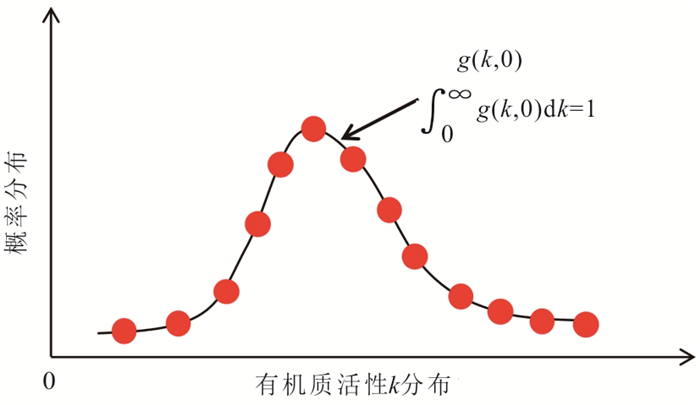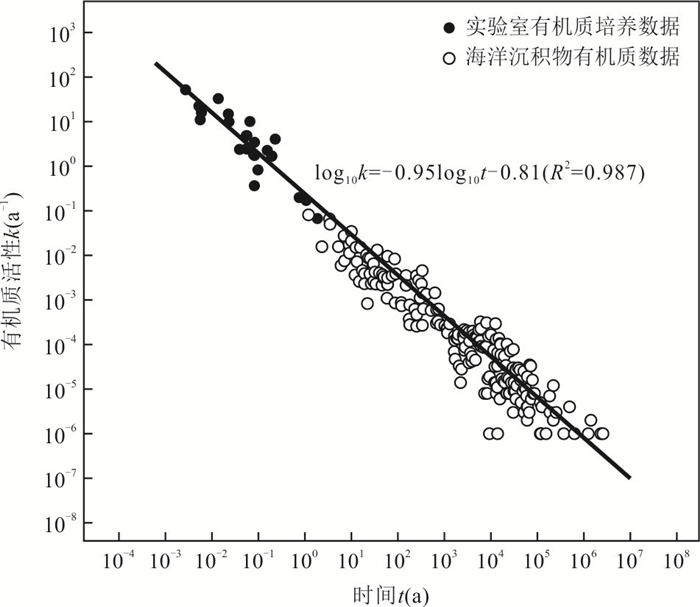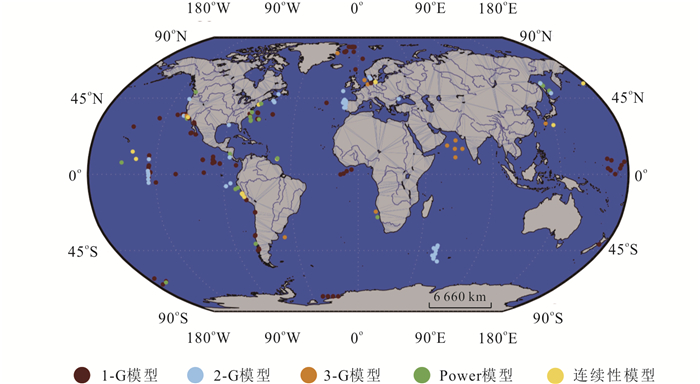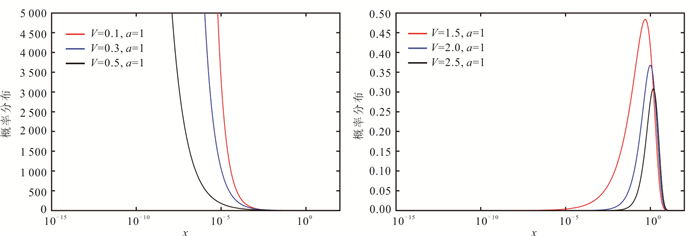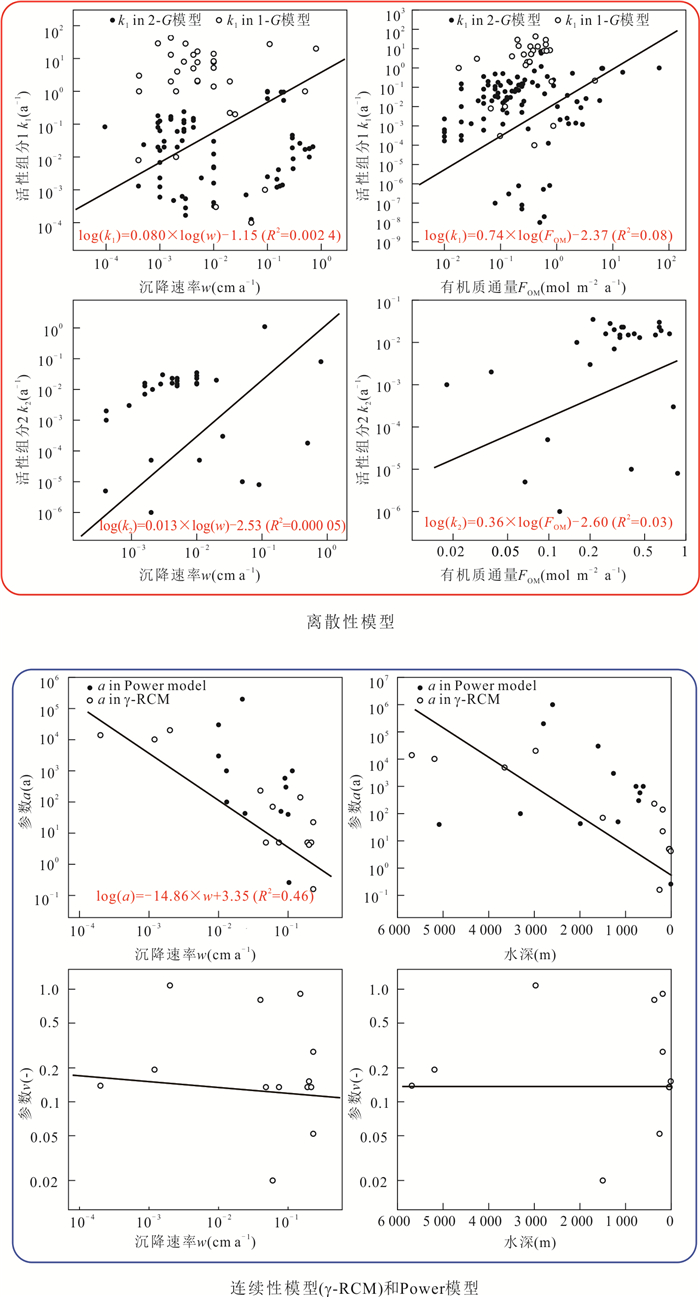Advances in Numerical Modelling of Carbon Cycling Processes in Marine Sediments
-
摘要: 海洋沉积物不仅是各种不同来源有机碳的重要埋藏场所,也是一个十分活跃的生物地球化学反应器,在全球海洋碳循环中扮演着重要角色.相对传统的地球化学测试和定性描述方法,数值模型可以突破时间和空间的限制,定量获取海洋沉积物中各个碳循环过程的反应速率及其通量,因此日益受到学界的重视.海洋沉积物有机质降解是驱动碳循环最为关键的生物地球化学过程,其释放进入周围孔隙水的溶解无机碳一部分可扩散至沉积物上覆水体,另一部分可与钙、镁等离子沉淀形成自生碳酸盐矿物.首先综述目前主要的3类沉积物有机质降解模型(离散性有机质降解模型、连续性有机质降解模型和Power模型)的建模过程及其在全球海洋沉积物有机质降解过程中的应用;接着从有机质降解相关的初级与次级反应出发,介绍沉积物中与有机质降解相关的地球化学过程反应速率模型的刻画方法,并从碳酸盐平衡体系和同位素质量平衡模式角度,探讨了沉积物有机质降解过程对自生碳酸盐形成及其碳同位素的影响;最后分析了当前阶段数学模型在描述有机质降解过程和自生碳酸盐形成中存在的问题和不足,并在此基础上展望未来亟需加强的研究要点,希企为深入理解海洋碳循环与全球气候变化相互反馈,建立可靠的海洋碳循环和生物地球化学预测系统提供有益的科学支撑.Abstract: Marine sediment is not only a critical burial area of organic carbon from various sources but also a very active biogeochemical reactor, which plays a vital role in the global marine carbon cycle. Compared with the geochemical testing and qualitative description methods, the numerical model can break through the limitations of time and space and quantitatively obtain the reaction rate and flux of each carbon cycle process in marine sediments. Therefore, it has been paid more and more attention by the academic community. The degradation of organic matter in marine sediments is the most critical biogeochemical process driving the carbon cycle. Part of the dissolved inorganic carbon released into the surrounding pore water can diffuse to the overlying water column. The other part can form authigenic carbonate minerals with calcium and magnesium plasma precipitation. In this paper it firstly reviews the modeling process of three main types of sediment organic matter degradation models (discrete model, reactive continuum model, and Power model) and their applications in the global marine sediment organic matter degradation process. Then, starting from the primary and secondary reactions related to the degradation of organic matter, the description method of the reaction rate model of geochemical processes related to the degradation of organic matter in sediments is introduced, and the influence of the degradation of organic matter on the formation of authigenic carbonates and their carbon isotopes is discussed from the perspective of carbonate equilibrium system and isotope mass balance model. Finally, the problems and shortcomings of the current mathematical model in describing the degradation process of organic matter and the formation of authigenic carbonate are analyzed, and on this basis, the research points that need to be strengthened in the future are prospected. It is hoped that in this paper it will provide useful scientific support for understanding the mutual feedback between the ocean carbon cycle and global climate change and establishing a reliable prediction system for ocean carbon cycle and biogeochemistry.
-
图 5 不同有机质降解模型在全球海洋沉积物中有机质降解过程的应用
Fig. 5. Application of different organic matter degradation models to organic matter degradation processes in global marine sediments
图 6 全球海洋可能发生自生碳酸盐沉淀的区域(a);全球海洋沉积物中水合物分布及其埋藏量(b)
图a引自Bradbury et al.(2019),图b引自Kretschmer et al.(2015). 图a中,红色圆点表示机器学习处理的站点,红色区域和绿色区域分别表示AOM主导和硫酸根还原主要的自生碳酸盐形成的区域
Fig. 6. Regions of the global ocean where authigenic carbonate precipitation is likely to occur (a); global hydrate distribution in marine sediments and its burial volume (b)
图 8 G模型、γ-RCM和Power模型参数与沉降速率、有机质通量之间的关系
Fig. 8. Relationship between G model, γ-RCM and Power model parameters and sedimentation rate and organic matter flux
表 1 沉积物中有机质相关的初级与次级反应,及其反应速率
Table 1. Primary and secondary redox reactions related to organic matter in sediments, and their reaction rates
地球化学反应 反应速率 初级反应 R1 CH2O+O2 → CO2+H2O -ROM R2 CH2O+4NO3- → 2N2+4HCO3-+CO2+3H2O -4·ROM R3 CH2O+2MnO2+3CO2+H2O → 2Mn2++4HCO3- 2·ROM R4 CH2O+4Fe(OH)3+7CO2 → 4Fe2++8HCO3-+3H2O 4·ROM R5 2CH2O+SO42- → H2S+2HCO3- 0.5·ROM R6 2CH2O+H2O → CH4+HCO3-+H+ 0.5·ROM 次级反应 R7 Fe2++HS-+HCO3- → FeS+CO2+H2O kFeHx·[Fe2+]·[HS-] R8 4Fe2++O2+8HCO3-+2H2O → 4Fe(OH)3+8CO2 kFeOx·[Fe2+]·[O2] R9 2Mn2++O2+4HCO3- → 2MnO2+4CO2+2H2O kMnOx·[Mn2+]·[O2] R10 H2S+2O2+2HCO3- → SO42-+2CO2+2H2O kSOx·[H2S]·[O2] R11 NH4++2O2+2HCO3- → NO3-+2CO2+3H2O kNHOx·[NH4+]·[O2] R12 CH4+O2 → CO2+2H2O kCHOx·[CH4]·[O2] R13 MnO2+2Fe2++3HCO3-+2H2O → 2Fe(OH)3+Mn2++4CO2 kMnFe·[MnO2]·[Fe2+] R14 MnO2+H2S+2CO2 → Mn2++S0+2HCO3- kMnHs·[MnO2]·[H2S] R15 H2S+2Fe(OH)3+4CO2 → 2Fe2++S0+4HCO3-+2H2O kFeHS·[Fe(OH)3]·[H2S] R16 FeS+2Fe(OH)3+6CO2 → 3Fe2++S0+6HCO3- kFeSFe·[Fe(OH)3]·[FeS] R17 FeS+4MnO2+8CO2+4H2O → 4Mn2++4Fe2++SO42-+8HCO3- kFeMnO·[FeS]·[MnO2] R18 FeS+2O2 → Fe2++SO42- kFeSOx·[FeS]·[O2] R19 CH4+SO42- → HCO3-+HS-+H2O kAOM·[CH4]·[SO42-] 注:[]表示括号中物质或元素的含量或浓度,ki表示动力学反应系数. -
Akam, S. A., Coffin, R. B., Abdulla, H. A. N., et al., 2020. Dissolved Inorganic Carbon Pump in Methane-Charged Shallow Marine Sediments: State of the Art and New Model Perspectives. Frontiers in Marine Science, 7: 206. https://doi.org/10.3389/fmars.2020.00206 Aller, R. C., Aller, J. Y., 1998. The Effect of Biogenic Irrigation Intensity and Solute Exchange on Diagenetic Reaction Rates in Marine Sediments. Journal of Marine Research, 56(4): 905-936. https://doi.org/10.1357/002224098321667413 Aris, R., 1968. Prolegomena to the Rational Analysis of Systems of Chemical Reactions II. Some Addenda. Archive for Rational Mechanics and Analysis, 27(5): 356-364. https://doi.org/10.1007/BF00251438 Arndt, S., Jørgensen, B. B., LaRowe, D. E., et al., 2013. Quantifying the Degradation of Organic Matter in Marine Sediments: A Review and Synthesis. Earth-Science Reviews, 123: 53-86. https://doi.org/10.1016/j.earscirev.2013.02.008 Ausín, B., Bruni, E., Haghipour, N., et al., 2021. Controls on the Abundance, Provenance and Age of Organic Carbon Buried in Continental Margin Sediments. Earth and Planetary Science Letters, 558: 116759. https://doi.org/10.1016/j.epsl.2021.116759 Bauer, J. E., Cai, W. J., Raymond, P. A., et al., 2013. The Changing Carbon Cycle of the Coastal Ocean. Nature, 504(7478): 61-70. https://doi.org/10.1038/nature12857 Bayon, G., Pierre, C., Etoubleau, J., et al., 2007. Sr/Ca and Mg/Ca Ratios in Niger Delta Sediments: Implications for Authigenic Carbonate Genesis in Cold Seep Environments. Marine Geology, 241(1/2/3/4): 93-109. https://doi.org/10.1016/j.margeo.2007.03.007 Berner, R. A., 1964. An Idealized Model of Dissolved Sulfate Distribution in Recent Sediments. Geochimica et Cosmochimica Acta, 28(9): 1497-1503. https://doi.org/10.1016/0016-7037(64)90164-4 Berner, R. A., 2020. Early Diagenesis. Princeton University Press, Princeton. https://doi.org/10.2307/j.ctvx8b6p2 Bin, Z., Peng, Y., Zuosheng, Y., et al., 2018. Reverse Weathering in River-Dominated Marginal Seas. Advances in Earth Science, 33: 42. https://doi.org/10.11867/j.issn.1001-8166.2018.01.0042 Blouet, J. P., Arndt, S., Imbert, P., et al., 2021. Are Seep Carbonates Quantitative Proxies of CH4 Leakage? Modeling the Influence of Sulfate Reduction and Anaerobic Oxidation of Methane on pH and Carbonate Precipitation. Chemical Geology, 577: 120254. https://doi.org/10.1016/j.chemgeo.2021.120254 Boudreau, B. P., 1996. A Method-of-Lines Code for Carbon and Nutrient Diagenesis in Aquatic Sediments. Computers & Geosciences, 22(5): 479-496. https://doi.org/10.1016/0098-3004(95)00115-8 Boudreau, B. P., 1997. Diagenetic Models and Their Implementation. Springer, Berlin. https://doi.org/10.1007/97S-3-642-60421-8 Boudreau, B. P., Ruddick, B. R., 1991. On a Reactive Continuum Representation of Organic Matter Diagenesis. American Journal of Science, 291(5): 507-538. https://doi.org/10.2475/ajs.291.5.507 Bradbury, H. J., Turchyn, A. V., 2019. Reevaluating the Carbon Sink Due to Sedimentary Carbonate Formation in Modern Marine Sediments. Earth and Planetary Science Letters, 519: 40-49. https://doi.org/10.1016/j.epsl.2019.04.044 Burdige, D. J., 2007. Preservation of Organic Matter in Marine Sediments: Controls, Mechanisms, and an Imbalance in Sediment Organic Carbon Budgets? Chemical Reviews, 107(2): 467-485. https://doi.org/10.1021/cr050347q Castanier S., Métayer-levrel G L, Perthuisot J P., 2000. Bacterial Roles in the Precipitation of Carbonate Miner-als. Microbial sediment, 32-39. https://doi.org/10.1007/978-3-662-04036-2_5 Charlou, J. L., Donval, J. P., Fouquet, Y., et al., 2004. Physical and Chemical Characterization of Gas Hydrates and Associated Methane Plumes in the Congo-Angola Basin. Chemical Geology, 205(3-4), 405-425. https://doi.org/10.1016/j.chemgeo.2003.12.033 Dale, A. W., Regnier, P., Van Cappellen, P., 2006. Bioenergetic Controls on Anaerobic Oxidation of Methane (AOM) in Coastal Marine Sediments: A Theoretical Analysis. American Journal of Science, 306(4): 246-294. https://doi.org/10.2475/ajs.306.4.246 Dunne, J. P., Sarmiento, J. L., Gnanadesikan, A., 2007. A Synthesis of Global Particle Export from the Surface Ocean and Cycling through the Ocean Interior and on the Seafloor. Global Biogeochemical Cycles, 21(4): GB4006. https://doi.org/10.1029/2006gb002907 Emerson, S., Fischer, K., Reimers, C., et al., 1985. Organic Carbon Dynamics and Preservation in Deep-Sea Sediments. Deep Sea Research Part A Oceanographic Research Papers, 32(1): 1-21. https://doi.org/10.1016/0198-0149(85)90014-7 Feng, D., Qiu, J. W., Hu, Y., et al., 2018. Cold Seep Systems in the South China Sea: An Overview. Journal of Asian Earth Sciences, 168: 3-16. https://doi.org/10.1016/j.jseaes.2018.09.021 Hansell, D. A., Carlson, C. A., 2015. Preface. Biogeochemistry of Marine Dissolved Organic Matter. Elsevier, Amsterdam: xvii-xviii. https://doi.org/10.1016/b978-0-12-405940-5.09990-8 Ho, T. C., Aris, R., 1987. On Apparent Second-Order Kinetics. AIChE Journal, 33(6): 1050-1051. https://doi.org/10.1002/aic.690330621 Huguet, C., De Lange, G. J., Gustafsson, Ö, et al., 2008. Selective Preservation of Soil Organic Matter in Oxidized Marine Sediments (Madeira Abyssal Plain). Geochimica et Cosmochimica Acta, 72(24): 6061-6068. https://doi.org/10.1016/j.gca.2008.09.021 Jørgensen, B. B., 1978. A Comparison of Methods for the Quantification of Bacterial Sulfate Reduction in Coastal Marine Sediments. Geomicrobiology Journal, 1(1): 29-47. https://doi.org/10.1080/01490457809377722 Jørgensen, B. B., 1983. Processes at the Sediment-Water Interface. Major Biogeochemical Cycles and Their Interactions, 25(6): 1421-1426. Kennedy, M. J., Pevear, D. R., Hill, R. J., 2002. Mineral Surface Control of Organic Carbon in Black Shale. Science, 295(5555): 657-660. https://doi.org/10.1126/science.1066611 Kretschmer, K., Biastoch, A., Rüpke, L., et al., 2015. Modeling the Fate of Methane Hydrates under Global Warming. Global Biogeochemical Cycles, 29(5): 610-625. https://doi.org/10.1002/2014gb005011 Krumins, V., Gehlen, M., Arndt, S., et al., 2013. Dissolved Inorganic Carbon and Alkalinity Fluxes from Coastal Marine Sediments: Model Estimates for Different Shelf Environments and Sensitivity to Global Change. Biogeosciences, 10(1): 371-398. https://doi.org/10.5194/bg-10-371-2013 LaRowe, D. E., Arndt, S., Bradley, J. A., et al., 2020a. The Fate of Organic Carbon in Marine Sediments—New Insights from Recent Data and Analysis. Earth-Science Reviews, 204: 103146. https://doi.org/10.1016/j.earscirev.2020.103146 LaRowe, D. E., Arndt S., Bradley, J. A., et al., 2020b. Organic Carbon and Microbial Activity in Marine Sediments on a Global Scale Throughout the Quaternary. Geochimica et Cosmochimica Acta, 286: 227-247. https://doi.org/10.1016/j.gca.2020.07.017 LaRowe, D. E., Van Cappellen, P., 2011. Degradation of Natural Organic Matter: A Thermodynamic Analysis. Geochimica et Cosmochimica Acta, 75(8): 2030-2042. https://doi.org/10.1016/j.gca.2011.01.020 Luff, R., Greinert, J., Wallmann, K., et al., 2005. Simulation of Long-Term Feedbacks from Authigenic Carbonate Crust Formation at Cold Vent Sites. Chemical Geology, 216(1/2): 157-174. https://doi.org/10.1016/j.chemgeo.2004.11.002 Luff, R., Haeckel, M., Wallmann, K., 2001. Robust and Fast FORTRAN and MATLAB Libraries to Calculate pH Distributions in Marine Systems. Computers & Geosciences, 27(2): 157-169. https://doi.org/10.1016/S0098-3004(00)00097-2 Luff, R., Wallmann, K., 2003. Fluid Flow, Methane Fluxes, Carbonate Precipitation and Biogeochemical Turnover in Gas Hydrate-Bearing Sediments at Hydrate Ridge, Cascadia Margin: Numerical Modeling and Mass Balances. Geochimica et Cosmochimica Acta, 67(18): 3403-3421. https://doi.org/10.1016/S0016-7037(03)00127-3 Maier-Reimer, E., Hasselmann, K., 1987. Transport and Storage of CO2 in the Ocean—An Inorganic Ocean-Circulation Carbon Cycle Model. Climate Dynamics, 2(2): 63-90. https://doi.org/10.1007/BF01054491 Meister, P., Liu, B., Ferdelman, T. G., et al., 2013. Control of Sulphate and Methane Distributions in Marine Sediments by Organic Matter Reactivity. Geochimica et Cosmochimica Acta, 104: 183-193. https://doi.org/10.1016/j.gca.2012.11.011 Michalopoulos, P., Aller, R. C., 1995. Rapid Clay Mineral Formation in Amazon Delta Sediments: Reverse Weathering and Oceanic Elemental Cycles. Science, 270(5236): 614-617. https://doi.org/10.1126/science.270.5236.614 Middelburg, J. J., 1989. A Simple Rate Model for Organic Matter Decomposition in Marine Sediments. Geochimica et Cosmochimica Acta, 53(7): 1577-1581. https://doi.org/10.1016/0016-7037(89)90239-1 Middelburg, J. J., Soetaert, K., Hagens, M., 2020. Ocean Alkalinity, Buffering and Biogeochemical Processes. Reviews of Geophysics, 58(3): e2019RG000681. https://doi.org/10.1029/2019rg000681 Middelburg, J. J., Soetaert, K., Herman, P. M., 1997. Empirical Relationships for Use in Global Diagenetic Models. Deep Sea Research Part I: Oceanographic Research Papers, 44(2): 327-344. https://doi.org/10.1016/S0967-0637(96)00101-X Mitnick, E. H., Lammers, L. N., Zhang, S., et al., 2018. Authigenic Carbonate Formation Rates in Marine Sediments and Implications for the Marine δ13C Record. Earth and Planetary Science Letters, 495: 135-145. https://doi.org/10.1016/j.epsl.2018.05.018 Mood, M. F., 1951. Introduction to the Theory of Statistics. Medical biological science, 5(2): 121-122. Morse, J. W., Arvidson, R. S., Lüttge, A., 2007. Calcium Carbonate Formation and Dissolution. Chemical Reviews, 107(2): 342-381. https://doi.org/10.1021/cr050358j Naehr, T. H., Eichhubl, P., Orphan, V. J., et al., 2007. Authigenic Carbonate Formation at Hydrocarbon Seeps in Continental Margin Sediments: A Comparative Study. Deep Sea Research Part II: Topical Studies in Oceanography, 54(11-13): 1268-1291. https://doi.org/10.1016/j.dsr2.2007.04.010 Nöthen, K., Kasten, S., 2011. Reconstructing Changes in Seep Activity by Means of Pore Water and Solid Phase Sr/Ca and Mg/Ca Ratios in Pockmark Sediments of the Northern Congo Fan. Marine Geology, 287(1-4): 1-13. https://doi.org/10.1016/j.margeo.2011.06.008 Reeburgh, W. S., 2007. Oceanic Methane Biogeochemistry. Chemical Reviews, 107(2): 486-513. https://doi.org/10.1021/cr050362v Regnier, P., Dale, A. W., Arndt, S., et al., 2011. Quantitative Analysis of Anaerobic Oxidation of Methane (AOM) in Marine Sediments: A Modeling Perspective. Earth-Science Reviews, 106(1/2): 105-130. https://doi.org/10.1016/j.earscirev.2011.01.002 Regnier, P., Dale, A. W., Pallud, C., et al., 2005. Incorporating Geomicrobial Processes in Reactive Transport Models of Subsurface Environments. Reactive Transport in Soil and Groundwater. Springer Berlin, Heidelberg, 109-125. https://doi.org/10.1007/3-540-26746-8_8 Sarmiento, J. L., Hughes, T. M. C., Stouffer, R. J., et al., 1998. Simulated Response of the Ocean Carbon Cycle to Anthropogenic Climate Warming. Nature, 393(6682): 245-249. https://doi.org/10.1038/30455 Schrag, D. P., Higgins, J. A., MacDonald, F. A., et al., 2013. Authigenic Carbonate and the History of the Global Carbon Cycle. Science, 339(6119): 540-543. https://doi.org/10.1126/science.1229578 Sun, J., 2023. How Many Pathways we Have for the Marine Carbon Neutrality. Journal of Earth Science, 34(5): 1621-1623. https://doi.org/10.1007/s12583-023-1892-5 Sun, Q. L., 2023. How does Global Warming Influence Seafloor Stability? Journal of Earth Science, 34(5): 1624-1625. https://doi.org/10.1007/s12583-023-1877-4 Sun, X. L., Turchyn, A. V., 2014. Significant Contribution of Authigenic Carbonate to Marine Carbon Burial. Nature Geoscience, 7(3): 201-204. https://doi.org/10.1038/ngeo2070 Vähätalo, A. V., Aarnos, H., Mäntyniemi, S., 2010. Biodegradability Continuum and Biodegradation Kinetics of Natural Organic Matter Described by the Beta Distribution. Biogeochemistry, 100(1): 227-240. https://doi.org/10.1007/s10533-010-9419-4 Van Cappellen, P., Wang, Y., 1996. Cycling of Iron and Manganese in Surface Sediments; A General Theory for the Coupled Transport and Reaction of Carbon, Oxygen, Nitrogen, Sulfur, Iron, and Manganese. American Journal of Science, 296(3): 197-243. https://doi.org/10.2475/ajs.296.3.197 Van Nugteren, P., Moodley, L., Brummer, G. J., et al., 2009. Seafloor Ecosystem Functioning: The Importance of Organic Matter Priming. Marine Biology, 156(11): 2277-2287. https://doi.org/10.1007/s00227-009-1255-5 Wang, X. J., Jin, J. P., Guo, Y. Q., et al., 2021. The Characteristics of Gas Hydrate Accumulation and Quantitative Estimation in the North Slope of South China Sea. Earth Science, 46(3): 1038-1057 (in Chinese with English abstract). Wu, Y. F., Guan, H. X., Xu, L. F., et al., 2022. Characteristics and Significance of Biomarkers Related to AOM in Surface Sediments of the Haima Cold Seep in the Northern South China Sea. Earth Science, 47(8): 3005-3015 (in Chinese with English abstract). Yoshinaga, M. Y., Holler, T., Goldhammer, T., et al., 2014. Carbon Isotope Equilibration during Sulphate-Limited Anaerobic Oxidation of Methane. Nature Geoscience, 7(3): 190-194. https://doi.org/10.1038/ngeo2069 Zeebe, R. E., Wolf-Gladrow, D., 2001. CO2 in Seawater: Equilibrium, Kinetics, Isotopes. Gulf Professional Publishing, Amsterdam. https://doi.org/10.1016/s0422-9894(01)x8001-x Zhang, S., Wang, L. C., 2013. Review on Carbon Cycling of Farmland Ecosystem under the Context of Global Changes. Journal of Agricultural Mechanization Research, 35(1): 4-9 (in Chinese with English abstract). Zhang, Y. H., Wu, Z. J., 2019. Sedimentary Organic Carbon Mineralization and Its Contribution to the Marine Carbon Cycle in the Marginal Seas. Advances in Earth Science, 34(2): 202-209 (in Chinese with English abstract). http://en.cnki.com.cn/Article_en/CJFDTOTAL-DXJZ201902012.htm Zhang, Z. S., Li, S. L., Wang, H. J., et al., 2022. Introduction of Crossing Disciplines between Geology and Atmospheric Science. Earth Science, 47(10): 3569-3579 (in Chinese with English abstract). Zhu, J. J., Li, S. Z., Lu, J. A., et al., 2020. Scientific Implications and Preliminary Surveying Results of Geological and Physical Oceanography Environment in the Shenhu Area of the Northern South China Sea. Earth Science, 45(4): 1416-1426 (in Chinese with English abstract). 王秀娟, 靳佳澎, 郭依群, 等, 2021. 南海北部天然气水合物富集特征及定量评价. 地球科学, 46(3): 1038-1057. doi: 10.3799/dqkx.2020.321 吴一帆, 管红香, 许兰芳, 等, 2022. 南海北部海马冷泉区表层沉积物的AOM生物标志化合物特征及意义. 地球科学, 47(8): 3005-3015. doi: 10.3799/dqkx.2021.202 张赛, 王龙昌, 2013. 全球变化背景下农田生态系统碳循环研究. 农机化研究, 35(1): 4-9. https://www.cnki.com.cn/Article/CJFDTOTAL-NJYJ201301004.htm 张咏华, 吴自军, 2019. 陆架边缘海沉积物有机碳矿化及其对海洋碳循环的影响. 地球科学进展, 34(2): 202-209. 张仲石, 李双林, 王会军, 等, 2022. 浅谈大气科学与地质学的学科交叉. 地球科学, 47(10): 3569-3579. doi: 10.3799/dqkx.2022.350 朱俊江, 李三忠, 陆敬安, 等, 2020. 南海北部神狐海域地质环境综合调查及科学意义. 地球科学, 45(4): 1416-1426. doi: 10.3799/dqkx.2019.109 -









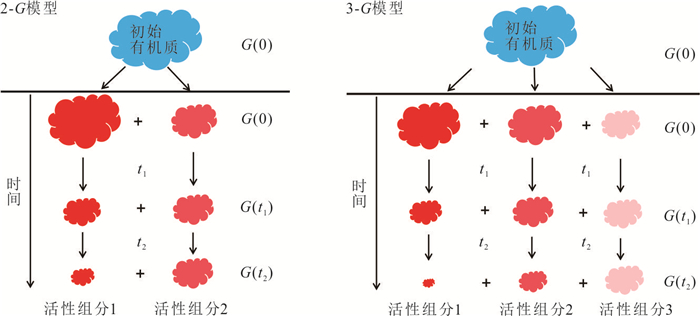
 下载:
下载:

